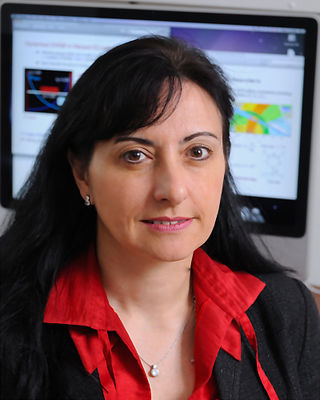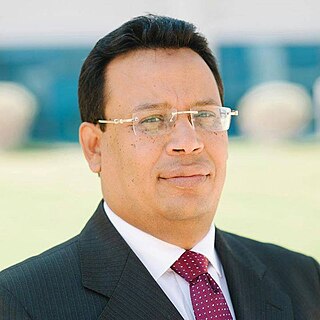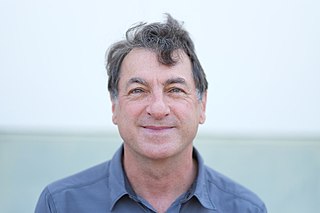
The University of the Philippines Diliman, also referred to as UP Diliman or simply University of the Philippines (UP), is a public, coeducational, research university located in Diliman, Quezon City, Philippines. It was established on February 12, 1949, as the flagship campus and seat of administration of the University of the Philippines System, the premier and national university of the Philippines.

Gabriele Veneziano is an Italian theoretical physicist widely considered the father of string theory. He has conducted most of his scientific activities at CERN in Geneva, Switzerland, and held the Chair of Elementary Particles, Gravitation and Cosmology at the Collège de France in Paris from 2004 to 2013, until the age of retirement there.

Jonathan Richard "John" Ellis is a British-Swiss theoretical physicist.

Maria Spiropulu is a Greek particle physicist. She is the Shang-Yi Ch'en Professor of Physics at the California Institute of Technology.

Thanu Padmanabhan was an Indian theoretical physicist and cosmologist whose research spanned a wide variety of topics in gravitation, structure formation in the universe and quantum gravity. He published nearly 300 papers and reviews in international journals and ten books in these areas. He made several contributions related to the analysis and modelling of dark energy in the universe and the interpretation of gravity as an emergent phenomenon. He was a Distinguished Professor at the Inter-University Centre for Astronomy and Astrophysics (IUCAA) at Pune, India.

The U.P. College of Science is one of the several colleges of the University of the Philippines Diliman, the flagship campus of the University of the Philippines System.

Caesar Aya-ay Saloma is a professor of the National Institute of Physics (NIP) at the University of the Philippines College of Science and a member of the National Academy of Science and Technology.
Mikaela Irene Dimaano Fudolig is a Filipino physicist and former child prodigy. She is known for earning her undergraduate degree at the age of 16.

Marcela Silvia Carena Lopez is an Argentine theoretical physicist, and distinguished scientist at the Fermi National Accelerator Laboratory in Batavia, Illinois, where she is also head of the lab's Theory Division. She is also a professor at the University of Chicago, where she is a member of the Enrico Fermi Institute and the Kavli Institute for Cosmological Physics.

Francesco Sannino is an Italian theoretical physicist and a professor at the University of Southern Denmark. He conducts research in the topics of effective field theories and their applications to strongly coupled theories such as quantum chromodynamics. He also researches in beyond standard model physics and quantum field theory.
Alexander Borisovich Zamolodchikov is a Russian physicist, known for his contributions to conformal field theory, statistical mechanics, string theory and condensed matter physics.
Dr. Henry Jacala Ramos is a professor emeritus of Physics at the University of the Philippines Diliman and the first Filipino experimental plasma physicist. He is the founder of the Plasma Physics Laboratory, National Institute of Physics, UP Diliman College of Science.

The University of the Philippines Baguio, also referred to as UP in the North or UP Baguio, is a public research university located in Baguio, Philippines. It was established in 1921 through the initiative of UP alumni in Baguio and Benguet and was inaugurated as the UP College of Baguio on April 22, 1961. It was eventually elevated to its present autonomous status as a constituent university on December 2, 2002.
Christopher Casenas Bernido is a Filipino physicist and educator. His achievements include research in exact solutions to quantum mechanical and biophysical problems using the Feynman path integral formulation. In 2010 he received the Ramon Magsaysay Award for contributing in both science and nation, ensuring innovative, low-cost, and effective basic education under Philippine conditions of scarcity and poverty.

The Philippine Earth Data Resource and Observation Center, also known as the PEDRO Center is an organization tasked in operating satellite ground stations.

Shaaban (Said) Khalil is a high energy physicist. He is the founding director of the Center for Fundamental Physics at Zewail City of Science and Technology in Egypt.

Mark John Bowick is a theoretical physicist in condensed matter theory and high energy physics. He is the deputy director of the Kavli Institute for Theoretical Physics at the University of California, Santa Barbara, and a Visiting Distinguished Professor of Physics in UCSB's Physics Department.
The Multispectral Unit for Land Assessment (MULA) is a planned Filipino satellite. Upon completion it will become the largest Filipino-made satellite.

Rana X. Adhikari is an American experimental physicist. He is a professor of physics at the California Institute of Technology (Caltech) and an associate faculty member of the International Centre for Theoretical Sciences of Tata Institute of Fundamental Research (ICTS-TIFR).





















